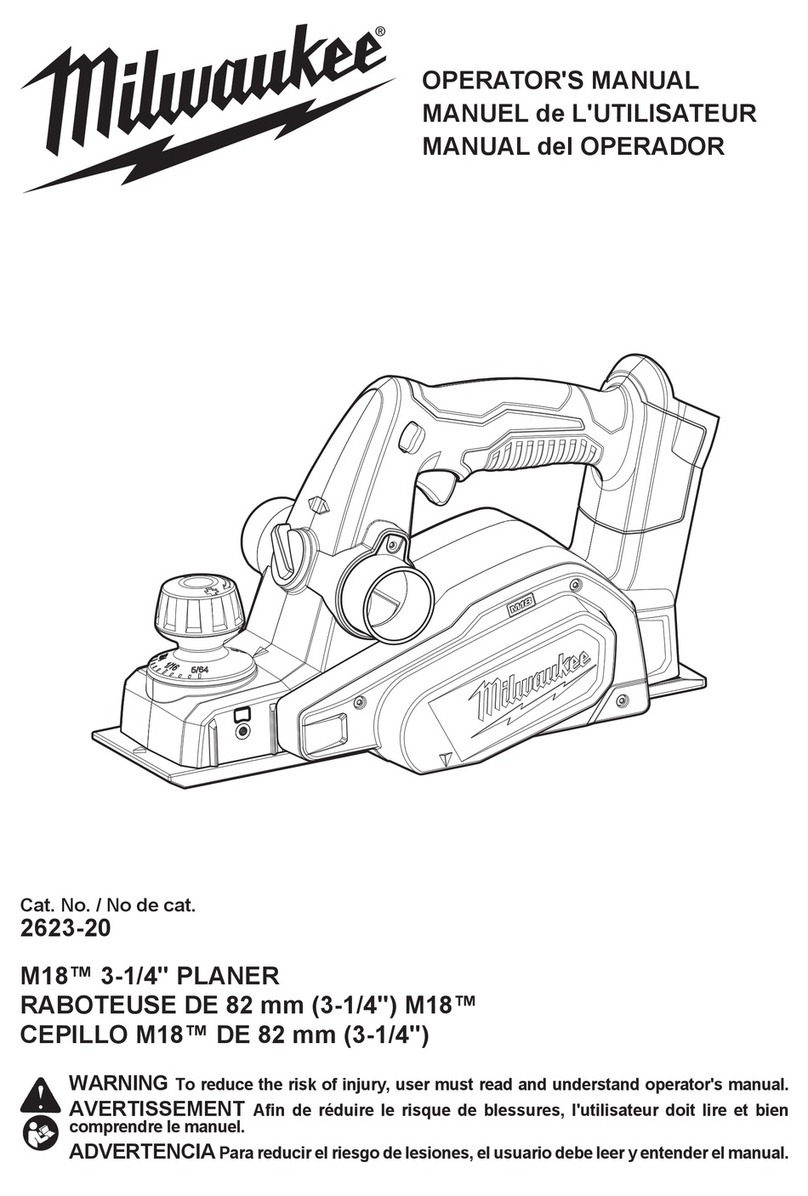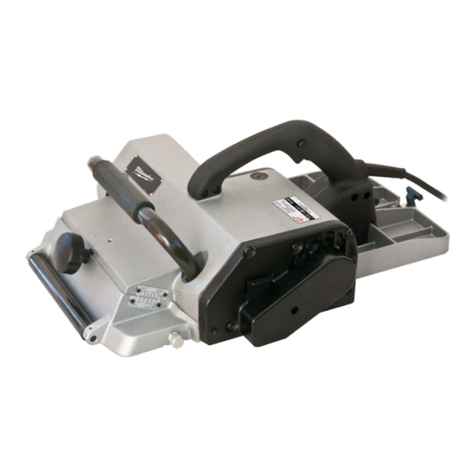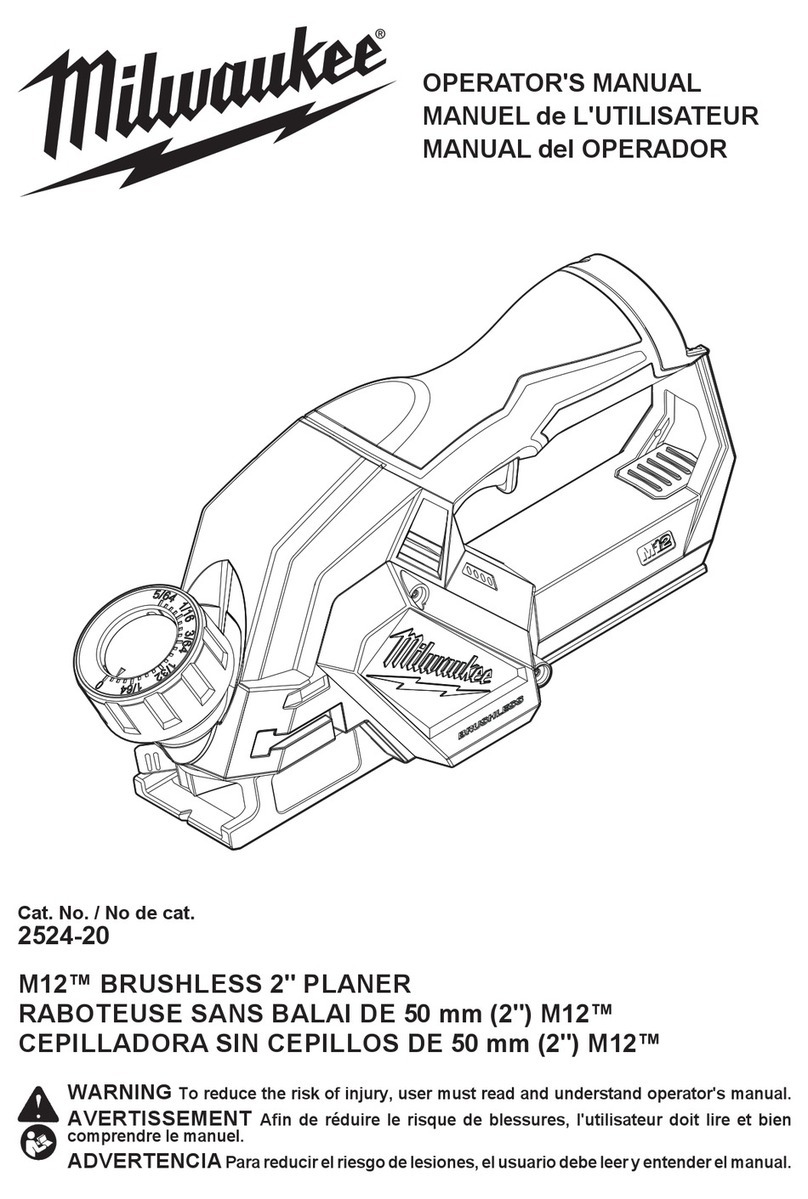
2
GENERAL POWER TOOL
SAFETY WARNINGS
:$51,1*
5HDGDOOVDIHW\ZDUQLQJVLQVWUXF
WORK AREA SAFETY
WLRQV SURYLGHG ZLWK WKLV SRZHU WRRO Failure to
follow all instructions listed below may result in
6DYH DOO
ZDUQLQJVDQGLQVWUXFWLRQVIRUIXWXUHUHIHUHQFH
The term "power tool" in the warnings refers to your
mains-operated (corded) power tool or battery-oper-
ated (cordless) power tool.
ELECTRICAL SAFETY
.HHSZRUN DUHDFOHDQ DQGZHOO OLWCluttered or
dark areas invite accidents.
'RQRWRSHUDWHSRZHUWRROVLQH[SORVLYHDWPR
OLTXLGVJDVHVRUGXVWPower tools create sparks
which may ignite the dust or fumes.
.HHSFKLOGUHQDQGE\VWDQGHUVDZD\ZKLOHRSHUDWLQJ
DSRZHUWRRODistractions can cause you to lose control.
PERSONAL SAFETY
6WD\DOHUWZDWFK ZKDW\RX DUH GRLQJDQG XVH
FRPPRQVHQVHZKHQRSHUDWLQJDSRZHUWRRO'R
QRWXVHDSRZHUWRROZKLOH\RXDUHWLUHGRUXQGHU
A
moment of inattention while operating power tools
may result in serious personal injury.
8VH SHUVRQDO SURWHFWLYH HTXLSPHQW $OZD\V
ZHDU H\H SURWHFWLRQ Protective equipment
such as a dust mask, non-skid safety shoes,
hard hat or hearing protection used for appropri-
ate conditions will reduce personal injuries.
3RZHU WRRO SOXJV PXVW PDWFK WKH RXWOHW
1HYHUPRGLI\WKHSOXJLQDQ\ZD\'RQRWXVH
DQ\ DGDSWHU SOXJV ZLWK HDUWKHG JURXQGHG
SRZHU WRROV Unmodified plugs and match-
ing outlets will reduce risk of electric shock.
$YRLGERG\ FRQWDFWZLWK HDUWKHGRU JURXQGHG
VXUIDFHVVXFKDVSLSHVUDGLDWRUVUDQJHVDQG
UHIULJHUDWRUVThere is an increased risk of electric
shock if your body is earthed or grounded.
'RQRWH[SRVHSRZHUWRROVWRUDLQRUZHWFRQGL
WLRQVWater entering a power tool will increase the
risk of electric shock.
'RQRWDEXVHWKHFRUG1HYHUXVHWKHFRUGIRU
FDUU\LQJSXOOLQJRUXQSOXJJLQJWKHSRZHUWRRO
.HHSFRUGDZD\IURPKHDWRLOVKDUSHGJHVRU
PRYLQJSDUWVDamaged or entangled cords increase
the risk of electric shock.
:KHQRSHUDWLQJDSRZHUWRRORXWGRRUVXVHDQH[
WHQVLRQFRUGVXLWDEOHIRURXWGRRUXVHUse of a cord
suitable for outdoor use reduces the risk of electric shock.
3UHYHQWXQLQWHQWLRQDOVWDUWLQJ(QVXUHWKHVZLWFK
VRXUFHDQGRUEDWWHU\SDFNSLFNLQJXSRUFDUU\LQJ
WKHWRRO
the switch or energising power tools that have the
switch on invites accidents.
5HPRYH DQ\ DGMXVWLQJ NH\ RU ZUHQFK EHIRUH
WXUQLQJWKHSRZHUWRRORQ A wrench or a key left
attached to a rotating part of the power tool may
result in personal injury.
POWER TOOL USE AND CARE
'R QRW RYHUUHDFK .HHS SURSHU IRRWLQJ DQG
EDODQFHDW DOOWLPHV This enables better control
of the power tool in unexpected situations.
,I GHYLFHV DUH SURYLGHG IRU WKH FRQQHFWLRQ RI
GXVWH[WUDFWLRQDQGFROOHFWLRQIDFLOLWLHVHQVXUH
WKHVHDUHFRQQHFWHGDQGSURSHUO\XVHGUse of
dust collection can reduce dust-related hazards.
'RQRWOHWIDPLOLDULW\JDLQHGIURPIUHTXHQWXVH
RIWRROVDOORZ \RXWREHFRPHFRPSODFHQWDQG
LJQRUHWRROVDIHW\SULQFLSOHVA careless action can
cause severe injury within a fraction of a second.
'RQRWIRUFHWKHSRZHUWRRO8VHWKHFRUUHFWSRZHU
WRROIRU\RXUDSSOLFDWLRQThe correct power tool
will do the job better and safer at the rate for which
it was designed.
'RQRWXVHWKHSRZHUWRROLIWKHVZLWFKGRHVQRW
Any power tool that cannot be
controlled with the switch is dangerous and must be
repaired.
BATTERY TOOL USE AND CARE
PDQXIDFWXUHUA charger that is suitable for one type
with another battery pack.
EDWWHU\SDFNVUse of any other battery packs may
:KHQEDWWHU\SDFNLVQRWLQXVHNHHSLWDZD\
IURPRWKHUPHWDOREMHFWVOLNHSDSHUFOLSVFRLQV
NH\VQDLOVVFUHZVRURWKHUVPDOOPHWDOREMHFWV
WKDWFDQPDNHDFRQQHFWLRQIURPRQHWHUPLQDO
WRDQRWKHUShorting the battery terminals together
'LVFRQQHFWWKHSOXJIURPWKHSRZHUVRXUFHDQG
RUUHPRYHWKHEDWWHU\SDFNLIGHWDFKDEOHIURP
WKHSRZHUWRROEHIRUHPDNLQJDQ\DGMXVWPHQWV
FKDQJLQJDFFHVVRULHVRUVWRULQJSRZHUWRROV
Such preventive safety measures reduce the risk of
starting the power tool accidentally.
6WRUHLGOHSRZHUWRROVRXWRIWKHUHDFKRIFKLOGUHQ
DQG GR QRW DOORZ SHUVRQV XQIDPLOLDU ZLWK WKH
SRZHUWRRORUWKHVHLQVWUXFWLRQVWRRSHUDWHWKH
SRZHUWRROPower tools are dangerous in the hands
of untrained users.
0DLQWDLQ SRZHU WRROV DQG DFFHVVRULHV &KHFN
IRU PLVDOLJQPHQW RU ELQGLQJ RI PRYLQJ SDUWV
EUHDNDJHRISDUWVDQGDQ\RWKHUFRQGLWLRQWKDW
KDYHWKHSRZHUWRROUHSDLUHGEHIRUHXVHMany ac-
cidents are caused by poorly maintained power tools.
.HHS FXWWLQJ WRROV VKDUS DQG FOHDQ Properly
maintained cutting tools with sharp cutting edges
are less likely to bind and are easier to control.
8VHWKHSRZHU WRRODFFHVVRULHV DQG WRROELWV
HWF LQ DFFRUGDQFH ZLWK WKHVH LQVWUXFWLRQV
WDNLQJ LQWR DFFRXQW WKH ZRUNLQJ FRQGLWLRQV
DQG WKH ZRUN WR EH SHUIRUPHG Use of the
power tool for operations different from those
intended could result in a hazardous situation.
.HHSKDQGOHVDQGJUDVSLQJVXUIDFHVGU\FOHDQ
DQGIUHHIURPRLODQGJUHDVHSlippery handles and
grasping surfaces do not allow for safe handling and
control of the tool in unexpected situations.
,IRSHUDWLQJDSRZHUWRROLQDGDPSORFDWLRQLV
XQDYRLGDEOH XVH D UHVLGXDO FXUUHQW GHYLFH
5&'SURWHFWHGVXSSO\Use of a RCD reduces
the risk of electric shock.
'UHVVSURSHUO\'RQRWZHDUORRVHFORWKLQJRU
MHZHOOHU\ .HHS \RXU KDLU DQG FORWKLQJ DZD\
IURP PRYLQJ SDUWV Loose clothes, jewellery or
long hair can be caught in moving parts.


































